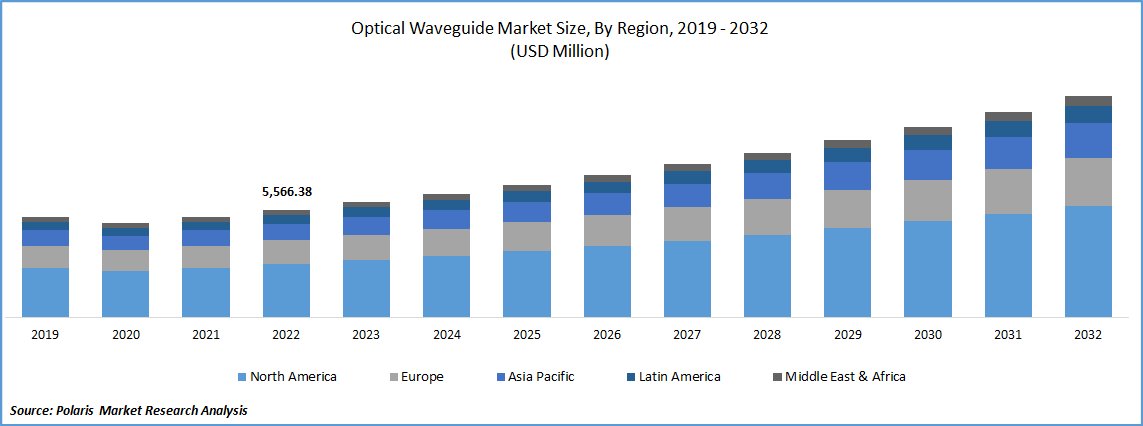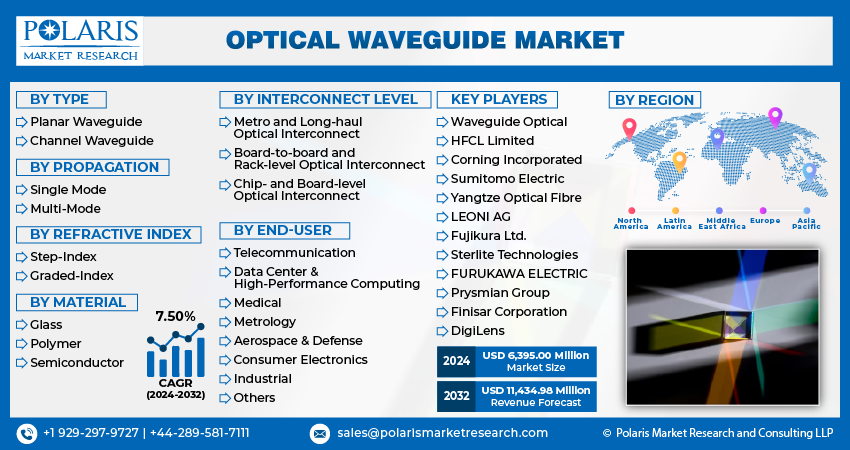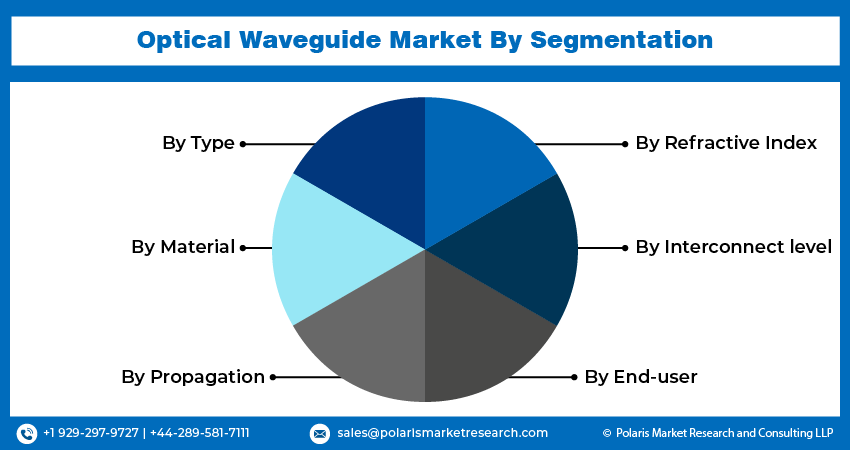
Optical Waveguide Market Share, Size, Trends, Industry Analysis Report
By Type (Planar Waveguide, Channel Waveguide); By Material; By Propagation; By Refractive Index; By Interconnect Level; By End-user; By Region; Segment Forecast, 2024-2032
- Published Date:Jan-2024
- Pages: 116
- Format: PDF
- Report ID: PM3151
- Base Year: 2023
- Historical Data: 2019-2022
Report Outlook
The global optical waveguide market was valued at USD 5,964.37 million in 2023 and is expected to grow at a CAGR of 7.50% during the forecast period. Numerous sectors, including telecommunications, data centers, medical equipment, consumer electronics, aerospace, and defense, employ optical waveguides in various applications. The market demand for increasing due to its properties, including high bandwidth, electromagnetic noise resistance, dispersed sensing capability, and biocompatibility. Medical devices like endoscopes and optical fiberscopes employ optical waveguides to send pictures from within the body and to offer high-speed data transfer. Optical waveguides transmit high-speed data for communication and navigation systems in aerospace and defense applications.

Know more about this report: Request for sample pages
Optical planar waveguide technology development has been fueled by a sharp rise in bandwidth demand that has outpaced copper's capabilities. Technological developments in fiber optics ensure that fiber will move closer to the end user, leading to new, more affordable, and densely packed devices. Optical waveguides send signals across vast distances in fiber optic communication networks. They are commonly used in data centers, telecommunications networks, and other communication systems and offer high-speed data transfer.
Optical waveguides are employed in optical sensing applications to detect changes in physical and chemical parameters, including temperature, pressure, and chemical composition. In sectors including the petrochemical, food and beverage, and pharmaceutical industries, they are extensively employed in process control and monitoring systems. Optical waveguides are used in lighting applications to illuminate display screens, keyboards, and other electronic device components. These applications are expected to bolster market demand for optical waveguides during the forecast period.
Industry Dynamics
Growth Drivers
The market is expanding due to the rising need for long-distance optical communication, notably in telecommunications. Additionally, advances in the performance and dependability of optical waveguides have been made possible by technical developments in this field, such as the creation of novel materials and production techniques which favorably impact the market. Government expenditures in the design and extension of fiber optic networks are also fueling the growth of the optical waveguide industry. The need for optical waveguides is being driven by the rising demand for services like high-definition video and multimedia networks, which utilize optical waveguides to offer high-speed data transfer.

Report Segmentation
The market is primarily segmented based on type, material, propagation, refractive index interconnect level, end-user and region.
|
By Type |
By Material |
By Propagation |
By Refractive Index |
By Interconnect level |
By End-user |
By Region |
|
|
|
|
|
|
|
Know more about this report: Request for sample pages
Channel waveguide segment is expected to held largest market share during the forecast period
The channel waveguide segment had the largest market share. Depending on their waveguide structure, channel waveguides are divided into ridge-type and buried-type waveguides. Channel waveguides provide low propagation loss. The performance of channel waveguides is improved by the reduced transverse scattering loss offered by their smooth wall surfaces. Channel waveguides can be twisted or curled to alter the guided waves' direction or provide a lateral shift.
In January 2022, Researchers at EPFL & ETH Zurich created a thin-film photonic device to create precisely customized terahertz frequency waves for next-generation 6G applications. The frequency, wavelength, amplitude, and phase are customized by the "photonic integrated circuit" (PIC) using a thin slice of lithium niobate on the Si substrate. This transmits terahertz waves produced by light from optical fibers using channels as waveguides and tiny antennas.
The planar waveguide segment is estimated to grow at a high CAGR during the projected period, which can be attributed to its compact size and cost-effectiveness compared to traditional optical fiber waveguides.
Polymer-based segment is expected to exhibit a substantial growth during the forecast period.
A polymer-based segment is expected to grow at the highest CAGR during the forecast period. They find applications in broadband communication like optical networking, MAN, and computing systems due to their easier processibility, integration, flexibility, and toughness over their inorganic counterparts. In January 2022, researchers were working on a flexible polymer optical waveguide that can be used in optogenetics implants in the future. These integrated bidirectional implantable ASICs have been operating in medical scenarios as well as other fields of applications.
Multi-mode propagation segment dominated the market during 2022
The multimode propagation segment held the largest market share. Multimode fiber is often used to transmit relatively shorter distances since the modes are more likely to spread over larger areas. Through moderately long distances, multimode fiber offers consumers a high bandwidth at fast speeds. Factors such as demand for high-speed data transmission, particularly in data centers and enterprise networks, and multimode waveguides being less expensive than their counterparts augment this segment growth.
The single-mode segment is expected to grow at a high CAGR during the forecast period. Data may be sent across greater distances at a fast speed using single-mode fibers. Signal attenuation and dispersion are minimized by single-mode waveguides, which is the reason for their increased adoption. Technological developments in single-mode waveguide technology, such as the creation of novel materials and production techniques, drive the growth of this market segment.
Board-to-board and rack level segment dominated the global market in 2022
The board-to-board and rack-level segments held the largest market share in 2022. The growing demand for energy-efficient communication systems, particularly in the data center market, is driving the growth of the board-to-board optical-to-interconnect market. In addition, the rising use of big data, machine learning, and the Internet of Things has greatly boosted the need for data centers and applications for high-performance computing. Over the forecast period, this is anticipated to drive the market expansion for the board-to-board and rack-level optical interconnects segment. The segment is also expected to exhibit substantial growth during the forecast period as demand for compact and lightweight interconnects rises and board-to-board interconnects are lightweight and easy to install.
Data center Segment is anticipated to exhibit the fastest growth during the forecast period.
The Telecommunications segment held the largest market share. The optical waveguide market is expanding due to the increased use of 5G technology, the expansion of fiber optic networks in emerging economies, and the rising need for long-distance optical communication, notably in the telecommunications sector. The increasing number of subscribers for different fixed-point and wireless communication devices, as well as the accessibility of affordable communication equipment, are some factors driving the segment's growth.
The data center segment is expected to grow at a high CAGR during the forecast period. Fiber optics technology is being quickly incorporated into data center networks. A fiber-based network for data centers is constructed by integrating several fiber optic devices. Today, most modern data center networks demand high-capacity data transmission, made possible using optical waveguides, which augment this segment's growth. In February 2023, a contract-in-force (CIF) was announced by Unitirreno Submarine Network to build a new optical fiber submarine cable system in the Tyrrhenian Sea. Providing a direct subsea connection to the developing data center cluster in the Rome region, Unitirreno will smoothly connect Genoa to Milan, Italy's primary data center hub.

Asia Pacific region is expected to grow at highest CAGR during the forecast period
Asia Pacific region is expected to grow at the highest CAGR during the forecast period. Increased adoption of high-speed networks for commercial purposes, particularly in developing nations, & the rise in the demand for reliability and bandwidth across various industries will all contribute to the market's continued expansion. Other drivers supporting the market's growth include rising internet usage, data traffic, and demands for the Internet of Things and more connected devices. In January 2023, TCL revealed its "RayNeo X2 AR-based smart glasses at CES 2023. These glasses combine with binocular Micro LED-based optical waveguide displays with innovative interactive capabilities to provide consumers with unique AR experiences.
North America held a substantial market share in 2022. Some of the biggest participants in the market are based in the country, which has a mature and fiercely competitive industry with a strong presence of both new and old firms. The need for optical waveguides is expanding due to more people using cloud computing and the growing demand for IoT, especially in the US. Optical waveguides allow high-speed data transmission in cloud data centers & IoT applications.

Competitive Insight
Some of the major players in the global market include Waveguide Optical, HFCL Limited, Corning Incorporated, Sumitomo Electric, Yangtze Optical Fibre, LEONI AG, Fujikura Ltd., Sterlite Technologies, FURUKAWA ELECTRIC, Prysmian Group, Finisar Corporation and DigiLens.
Recent Developments
- In January 2023, Lumus introduced a recent iteration of display architecture. This technology from Lumus will enable smaller, lighter AR eyeglasses with superb image quality, brightness, & seamless Rx integration.
- In January 2023, DigiLens introduced a standalone AR/XR device made specifically for business and industrial-lite workers called ARGO. The ARGO smart glasses from DigiLens have the best-in-class crystal waveguides, the smallest possible footprint, the least eye glow in the industry, and daylight brightness for indoor and outdoor use. This makes the product more sociable and user-friendly.
Optical Waveguide Market Report Scope
|
Report Attributes |
Details |
|
Market size value in 2024 |
USD 6,395.00 million |
|
Revenue forecast in 2032 |
USD 11,434.98 million |
|
CAGR |
7.50% from 2024 – 2032 |
|
Base year |
2023 |
|
Historical data |
2019 – 2022 |
|
Forecast period |
2024 – 2032 |
|
Quantitative units |
Revenue in USD million and CAGR from 2024 to 2032 |
|
Segments covered |
By Type, By Material, By Propagation, By Refractive Index, By Interconnect Level, By End-user, By Region |
|
Regional scope |
North America, Europe, Asia Pacific, Latin America; Middle East & Africa |
|
Key companies |
Waveguide Optical Technologies, HFCL Limited, Corning Incorporated, Sumitomo Electric Industries, Ltd., Yangtze Optical Fibre, LEONI AG, Fujikura Ltd., Sterlite Technologies Limited., FURUKAWA ELECTRIC CO., LTD., Prysmian Group, Finisar Corporation and DigiLens Inc. |
FAQ's
The global Optical Waveguide market size is expected to reach USD 11,434.98 million by 2032.
Key players in the optical waveguide market are Waveguide Optical, HFCL Limited, Corning Incorporated, Sumitomo Electric, Yangtze Optical Fibre, LEONI AG, Fujikura Ltd., Sterlite Technologies, FURUKAWA ELECTRIC.
Asia Pacific contribute notably towards the global optical waveguide market.
The global optical waveguide market expected to grow at a CAGR of 7.5% during the forecast period.
The optical waveguide market report covering key segments are type, material, propagation, refractive index interconnect level, end-user and region.
